I promised I would describe the new scripts in more detail, and try to explain how they related to the feature.
One script, with the working title of Reconciliation, will borrow the form, without shame, from Haneke's 71 Fragments. Principally these are the short fragments, of one to many, which are followed by a short cut to black, and which constitute a scene, in loose terms. Reconciliation, at present is made of 8 scenes. At present I am uncertain the number of shots per scene, but my aim is to keep these to a minimum, if not 1. I am also thinking of Haneke's Code Unknown, which followed the 1 shot = 1 scene convention, but he allowed for some complex camera movements, such as the elaborate opening sequence in the Paris street, which are out of the question for a budget such as mine.
Besides these conventions, the rule is that there is no cutting on action, in the conventional sense, a minimal of dialogue (two sentences, 1 each), which consequentially means I rely on visual storytelling, and compression and minimalism, so that little will mean more.
I am interested (have always been interested) in structures that allow for cumulative and amplifying affects, to create an impression, as opposed to linear narratives. I was taken, many years ago, on seeing Buchner's Woyceck (http://en.wikipedia.org/wiki/Woyzeck).
What is this story about? As the title indicates, it is about reconciliation, in this case between an estranged couple, on the verge of separating. It is set over 1 day, starting the morning and ending in early evening, in which they never speak, and find that reconciliation comes in the mundane, everyday events, not in grand gesture. In fact I think I am using an anti-grand gesture. And finally, that this anti-grand gesture leads a sense of the transcendent, for him at least. Their reconciliation is not romantic, but is found in an accommodation with the natural world.
I hope this doesn't sound terrible pretentious. I will have to be careful I am honest.
Tuesday, February 27, 2007
Sunday, February 18, 2007
More on Haneke
I watched Haneke's 71 Fragments of a Chronology of Chance again this past Saturday.
I have already mentioned that I was interested in using this form as a contrivance to work with some short film ideas.
What is the form?
There are 71 fragments, or shots (actually I don't know that there is, I didn't count them), and in combination make up scenes. I use the term scenes loosely. They are marked by the use of a black fragment at the end of the scene.
The number of shots per scene varies from one short shot, to one very-long shot (in time, not in terms of the lens), which is 9 minutes long, to scenes which are made of up 13 individual shots.
The scenes revolve around groups of characters who all will cross paths by chance at the end of the film, in the bloody ending. The story moves from one set of characters to another.
More about these scenes:
It attracted me for a lot of reasons, but fundamentally, by reducing the elements to a minimum it allows the filmmaker to compress and so say a lot more in a short film than can be said in a film with a conventional structure.
I have already mentioned that I was interested in using this form as a contrivance to work with some short film ideas.
What is the form?
There are 71 fragments, or shots (actually I don't know that there is, I didn't count them), and in combination make up scenes. I use the term scenes loosely. They are marked by the use of a black fragment at the end of the scene.
The number of shots per scene varies from one short shot, to one very-long shot (in time, not in terms of the lens), which is 9 minutes long, to scenes which are made of up 13 individual shots.
The scenes revolve around groups of characters who all will cross paths by chance at the end of the film, in the bloody ending. The story moves from one set of characters to another.
More about these scenes:
- though there were scenes of up to thirteen shots, most of the scenes involved three shots
- there were sequences with one shot with camera movement, such as a pan or tilt up
- some shots involved a focus-pull
- variety of CU, MS and inserts
- but he never cuts on action (that is he would not cut from a MS of man sitting in chair to a CU of man sitting in chair on the action of sitting. He preserves the fragments). Each individual shot stands by itself
It attracted me for a lot of reasons, but fundamentally, by reducing the elements to a minimum it allows the filmmaker to compress and so say a lot more in a short film than can be said in a film with a conventional structure.
An update and new projects
Just a short note to say that since finishing the first draft of the script I have been busy working on a few short film ideas. Basically, I want to experiment with some of the ideas I have been discussing here before I commit to a feature.
I have to say that I basically don't like short films. Fundamentally, I believe they are another form from features. There are a few things you can learn from them, but much more that you don't, such as building a character and sustaining a story over 90 minutes plus.
But the main problem I have with short films is my own lack of short-film ideas. I really don't think in those terms.
It was seeing Haneke's film 71 Fragments of a Chronology of Chance that changed my outlook. I decided that I could use this form to generate ideas. It is really a contrivance.
I have three short scripts, one of which I feel is ready to shoot. I conceived of it over Christmas, which I spend in Berlin. I went with a friend. We would wander about for most of the morning and afternoon, and then being tired and cold we would retire to our rooms to recover before the evenings. I took advantage of the large bathtub to work. I find, like many before me, that the combination of heat, and water to be conducive to working.
The second script is probably the weakest, though I did make some progress with it over this weekend.
The third needs fleshing out.
The plan is to shoot all three before the summer is done, while developing the feature project further. More on these scripts later.
I have to say that I basically don't like short films. Fundamentally, I believe they are another form from features. There are a few things you can learn from them, but much more that you don't, such as building a character and sustaining a story over 90 minutes plus.
But the main problem I have with short films is my own lack of short-film ideas. I really don't think in those terms.
It was seeing Haneke's film 71 Fragments of a Chronology of Chance that changed my outlook. I decided that I could use this form to generate ideas. It is really a contrivance.
I have three short scripts, one of which I feel is ready to shoot. I conceived of it over Christmas, which I spend in Berlin. I went with a friend. We would wander about for most of the morning and afternoon, and then being tired and cold we would retire to our rooms to recover before the evenings. I took advantage of the large bathtub to work. I find, like many before me, that the combination of heat, and water to be conducive to working.
The second script is probably the weakest, though I did make some progress with it over this weekend.
The third needs fleshing out.
The plan is to shoot all three before the summer is done, while developing the feature project further. More on these scripts later.
Sunday, February 11, 2007
Update
I have just now finished the revisions of the first draft of the script. I am planning to send it to the Script Factory for a paid reading.
Outside of that I think it time to put aside for a while. I need to regain some objectivity.
I will continue to look for locations and post photos.
And I am planning some other ways I will work on the story in the next month.
More on that later.
Outside of that I think it time to put aside for a while. I need to regain some objectivity.
I will continue to look for locations and post photos.
And I am planning some other ways I will work on the story in the next month.
More on that later.
Schrader and the Transcendental Style - Ozu
I continue to work my way through Schrader's book, Transcendental Style in Film. It is dense, and requires rereading, and retouching of the films he is describing. I have Ozu's Tokyo Story and Late Spring next to my bed, so that I can go over his references.
Some more examples of Schrader's second part, Disparity.
Setsuko's Hora's tears near the end of Tokyo Story . I find this an interesting example, for the final sequence of the film, the ship going upriver.
This would be part three of the form: stasis, "...which does not resolve the disparity but transcends it."
Another example of stasis at the end of Late Spring. Father and daughter have gone away for one last time together, before she is to be married. They discuss the day as they get ready for sleep. After a time, asking him a question and getting no response, she sees he is asleep. Ozu cuts back to the daughter seeing he is asleep. Then we see one of what Schrader's describes as Ozu's codas: the still shot of a vase. (It is not clear from our view of her if she has been looking at the vase from her bed. I suppose because it doesn't matter. We can only assume the vase is in the same room. That is all there is of realism).
Then Ozu returns to the daughter, now half-smiling. Then the vase again, this time a longer sequence. Then the daughter again, now nearly in tears.
And then the vase again.
The vase being stasis accepts seems to accept all these very different emotions and states "...and transform it into an expression of something unified, permanent, transcendent."
Some more examples of Schrader's second part, Disparity.
Setsuko's Hora's tears near the end of Tokyo Story . I find this an interesting example, for the final sequence of the film, the ship going upriver.
The final codas of Ozu's films are reaffirmations of nature; they are the final silence and emptiness.
This would be part three of the form: stasis, "...which does not resolve the disparity but transcends it."
Another example of stasis at the end of Late Spring. Father and daughter have gone away for one last time together, before she is to be married. They discuss the day as they get ready for sleep. After a time, asking him a question and getting no response, she sees he is asleep. Ozu cuts back to the daughter seeing he is asleep. Then we see one of what Schrader's describes as Ozu's codas: the still shot of a vase. (It is not clear from our view of her if she has been looking at the vase from her bed. I suppose because it doesn't matter. We can only assume the vase is in the same room. That is all there is of realism).
Then Ozu returns to the daughter, now half-smiling. Then the vase again, this time a longer sequence. Then the daughter again, now nearly in tears.
And then the vase again.
The vase being stasis accepts seems to accept all these very different emotions and states "...and transform it into an expression of something unified, permanent, transcendent."
Monday, February 05, 2007
More of Scene 50 locations
I awoke early on Sunday to catch the rising sun on Hampstead Heath, but when I looked out the window I found there was a lot fog. I would not be able to get even semi-clear shots of London and I didn't need a lot of excuses to stay in bed.
Still I did manage to catch the sun going down. It was a beautiful day, sunny, but with a little mist and fog leftover from the morning. This was actually better than the clear conditions I had several weeks ago. I imagine Paul waking to see a little mist over London.
But I was really looking for a location for scene 50, where Claire runs after Nick into the park. She has dismissed him, realising that they have been both deluding themselves. But when he is gone she has a relapse. Was this real? She goes after him.
I had early posted some images of a place where two paths cross, but I was not happy with this location. One of the trails ascends quickly. She really needs to be looking down when she looks for him. Why not turn the camera the other way? It seems obvious, but there are a set of trees at the bottom of the crossing so she would really be able to see anything. Not what is required. So Sunday I was looking for another location.
I found another hill on which a trail ascends and there is clear vantage point.
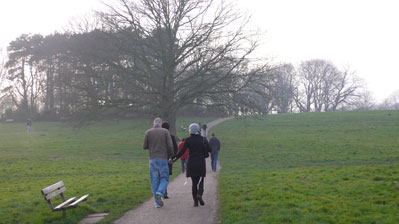
There is no crossing on this hill, but I realised this is for the best: the crossing image has the potential to be read as some sort of symbol (she is at a crossroads, blah blah), something I am desperate to avoid.
So I went up the hill.
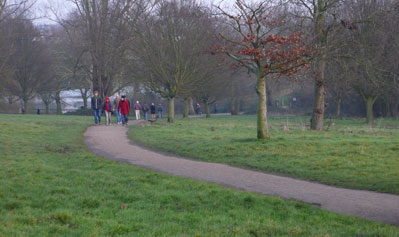
There is a the clear line of the path below and the rest of the hill.
I liked the mix of hills, and banks of trees that create a series of background and foreground images.
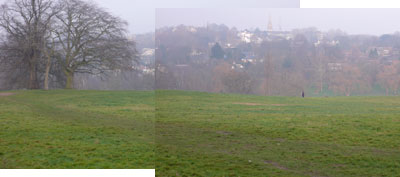
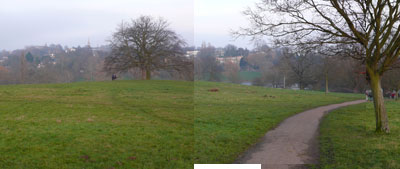
To her right were a stand of trees with a flock of black birds nesting at the top. I assumed they were crows.
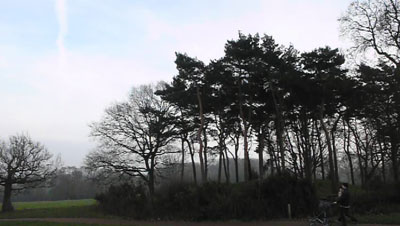
They created a Hitchcock quality to the scene - inappropriate for my film, but it added to the fun of the afternoon.
From the vantage point in the park she should be able to see him. But he has disappeared.
She wants to accept defeat. Near the path is a tree, and she comes onto the grass and collapses. Surrenders.
She scans the sky for some relief, but there is none. A nothing.
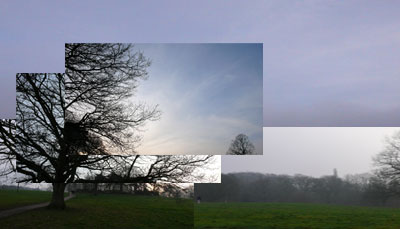
Then the iconic moment.
Still I did manage to catch the sun going down. It was a beautiful day, sunny, but with a little mist and fog leftover from the morning. This was actually better than the clear conditions I had several weeks ago. I imagine Paul waking to see a little mist over London.
But I was really looking for a location for scene 50, where Claire runs after Nick into the park. She has dismissed him, realising that they have been both deluding themselves. But when he is gone she has a relapse. Was this real? She goes after him.
I had early posted some images of a place where two paths cross, but I was not happy with this location. One of the trails ascends quickly. She really needs to be looking down when she looks for him. Why not turn the camera the other way? It seems obvious, but there are a set of trees at the bottom of the crossing so she would really be able to see anything. Not what is required. So Sunday I was looking for another location.
I found another hill on which a trail ascends and there is clear vantage point.

There is no crossing on this hill, but I realised this is for the best: the crossing image has the potential to be read as some sort of symbol (she is at a crossroads, blah blah), something I am desperate to avoid.
So I went up the hill.

There is a the clear line of the path below and the rest of the hill.
I liked the mix of hills, and banks of trees that create a series of background and foreground images.


To her right were a stand of trees with a flock of black birds nesting at the top. I assumed they were crows.

They created a Hitchcock quality to the scene - inappropriate for my film, but it added to the fun of the afternoon.
From the vantage point in the park she should be able to see him. But he has disappeared.
She wants to accept defeat. Near the path is a tree, and she comes onto the grass and collapses. Surrenders.
She scans the sky for some relief, but there is none. A nothing.
Then the iconic moment.
Sunday, February 04, 2007
Schrader and the Transcendental Style
I mentioned earlier that I was working my way through Schrader's book, Transcendental Style in Film (available on ABEbooks or Amazon). It analyses the films styles of Ozu, Bresson and Dreyer and shows how by way of form they create a transcendental style.
I have only just begun working my way through the Ozu section. Here Schrader first unravels the personality of Ozu, and his culture, from the transcendental style.
This quality strips the action of any expression, and in this way differs from what is known as realism. There is no drama, no melodrama. This quality, this silence, prepares the ground for the transcendental.
Ozu was quite famous for his austere style. As his career progressed he used fewer and fewer conventional film techniques.
He almost always placed the camera at the same height, that which the viewer would see another sitting on the traditional Japanese tatami mat. The actor faced the camera directly. The camera never moved.
I wondered how these everyday events differed in the work of more contemporary artists. Think of Kieslowski in The Double of Veronique. Veronique at home, reading a book, dozing in a chair. In interviews Irene Jacob said how these were not the events one described to a loved one at the end of the day. There is no drama or interest. But it is in precisely these mundane events that are filled with feelings and premonitions. These events completed the character.
I need to read more of Schrader to say if Kieslowski is doing something completely different in his work.
I am also reminded of Haneke, and the different way he uses mundane events in two of his films, 71 Fragments of a Chronology of Chance, and The 7th Continent. I have described these scenes earlier, and I feel confident saying that Haneke is not interested in the transcendental. But what is he doing then?
For the Zen philosopher, like Ozu the tension comes about when man is not one with nature.
In Ozu these disunities might be may be something as dramatic as a character suddenly breaking out in tears (Setsuko Hara), divorced from psychological realism and cause and effect. But Ozu being Ozu the disunities are generally not so dramatic. It may be an ironic comment, such as the Mother in Tokyo Story saying with irony 'what a treat to sleep on my dead son's bed'. The irony is usually a symptom of this disunity, and creates a tension that in a conventional film must be resolved.
The final step is:
Kieslowski seems to describe the transcendental very differently. For example, when Veronique is awoken from her sleep by the light flashing in her eyes. At first she thinks it is schoolboy trick. A boy across the way is playing with a mirror. But when he goes inside the light returns. This technique is very different from Ozu's codas.
I will talk more of this as I go further into the book.
I have only just begun working my way through the Ozu section. Here Schrader first unravels the personality of Ozu, and his culture, from the transcendental style.
...the common qualities of transcendental style and take the form of three progressive steps.
1. The everyday: a meticulous representation of the dull, banal commonplaces of everyday living...
This quality strips the action of any expression, and in this way differs from what is known as realism. There is no drama, no melodrama. This quality, this silence, prepares the ground for the transcendental.
Ozu was quite famous for his austere style. As his career progressed he used fewer and fewer conventional film techniques.
He almost always placed the camera at the same height, that which the viewer would see another sitting on the traditional Japanese tatami mat. The actor faced the camera directly. The camera never moved.
I wondered how these everyday events differed in the work of more contemporary artists. Think of Kieslowski in The Double of Veronique. Veronique at home, reading a book, dozing in a chair. In interviews Irene Jacob said how these were not the events one described to a loved one at the end of the day. There is no drama or interest. But it is in precisely these mundane events that are filled with feelings and premonitions. These events completed the character.
I need to read more of Schrader to say if Kieslowski is doing something completely different in his work.
I am also reminded of Haneke, and the different way he uses mundane events in two of his films, 71 Fragments of a Chronology of Chance, and The 7th Continent. I have described these scenes earlier, and I feel confident saying that Haneke is not interested in the transcendental. But what is he doing then?
2. Disparity: an actual or potential disunity between man and his environment which culminates in a decisive action.
For the Zen philosopher, like Ozu the tension comes about when man is not one with nature.
In Ozu these disunities might be may be something as dramatic as a character suddenly breaking out in tears (Setsuko Hara), divorced from psychological realism and cause and effect. But Ozu being Ozu the disunities are generally not so dramatic. It may be an ironic comment, such as the Mother in Tokyo Story saying with irony 'what a treat to sleep on my dead son's bed'. The irony is usually a symptom of this disunity, and creates a tension that in a conventional film must be resolved.
The final step is:
3. Stasis: a frozen view of life which does not resolve the disparity but transcends it.In Ozu's zen universe man is again one with nature, and may be indicated by his codas, those static shots of everyday objects, such as the equipment in the sake factory in The End of Summer. Or the different shots of the vase in the near the end of Late Spring. It suggests another reality beyond the mundane events described early.
Kieslowski seems to describe the transcendental very differently. For example, when Veronique is awoken from her sleep by the light flashing in her eyes. At first she thinks it is schoolboy trick. A boy across the way is playing with a mirror. But when he goes inside the light returns. This technique is very different from Ozu's codas.
I will talk more of this as I go further into the book.
Friday, February 02, 2007
Progress report
Just a short post to update you on the project. What have I been doing?
I am near completion of the first draft of the script - it would been complete last weekend but for some ideas I wanted to explore. I have added these into the outline and just need to put them in the script.
I am looking forward to taking a break from writing. I am sure you screenwriters understand how preoccupied you become getting close to finishing a draft.
On Sunday I will be up early scouting for locations in Hampstead Heath. I hope to upload a lot more photos in the next few weeks.
I have been reading a great book by Paul Schrader, Transcendental Style in Film, which discusses Ozu, Bresson, and Dryer. Much more on this soon.
I am near completion of the first draft of the script - it would been complete last weekend but for some ideas I wanted to explore. I have added these into the outline and just need to put them in the script.
I am looking forward to taking a break from writing. I am sure you screenwriters understand how preoccupied you become getting close to finishing a draft.
On Sunday I will be up early scouting for locations in Hampstead Heath. I hope to upload a lot more photos in the next few weeks.
I have been reading a great book by Paul Schrader, Transcendental Style in Film, which discusses Ozu, Bresson, and Dryer. Much more on this soon.
Subscribe to:
Posts (Atom)